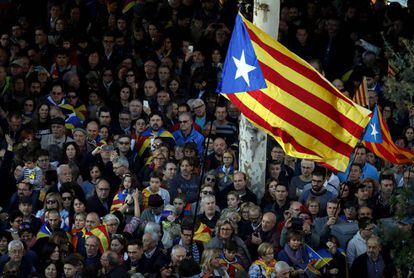The strategy for the construction of the Spanish enemy
Pro-independence forces have spent decades creating a compendium of grievances that place Spain at the source of all of Catalonia’s ills

“Compendium of grievances: Catalonia is a nation that is being discriminated against, that cannot freely develop its cultural and economic potential. Uncover, establish, assess and disseminate evidence of discrimination, deficiencies, etc. in a clear, assertive and systematic way. Underscore the negative effects that this has on the Catalan people as a whole and on each one of its citizens.”
This quote is not taken from anything written in recent years, when the separatist process officially got underway. It actually dates back to 1990, when the Catalan government – then still under longtime leader Jordi Pujol – entrusted a group of Catalan intellectuals with the drafting of a document entitled “The Strategy of Catalanization.”
What Rajoy has managed to do is to lob the conflict back into Catalonia
Joan Navarro, sociologist
The 20-page document was presented in the fall of that year, and it marked the beginning of the creation of a pro-independence rhetoric that would ultimately turn Spain into the source of all evil. That’s when construction work began on creating an enemy of the Catalan people. First it was “Spain doesn’t understand us.” Later it became “Spain is robbing us.” And finally, the message evolved into “Spain is oppressing us.”
It is a classic strategy in politics, as in war, to create an enemy so inhuman that the only possible way to deal with him is to destroy him. It’s either us or them.
Now, 27 years after that seminal document first saw the light, the separatist movement has managed to attract the vote of over 40% of Catalans who went to the polls at the regional election of September 2015. And two million citizens voted in favor of a Catalan republic at the unconstitutional referendum of October 1. These figures are far from negligible.

Even though the referendum was illegal, lacked basic democratic guarantees and failed on transparency requirements, it nevertheless reflected a growing tide of separatism in Catalonia, where pro-independence sentiment has doubled since 2010. Opinion polls currently suggest a tie between separatists and unionists at the upcoming snap election of December 21.
Gone are the days when Jordi Pujol used to offer himself as a bulwark against separatism in exchange for a different model of relations between Madrid and Barcelona. Or when his successor, the Socialist Pasqual Maragall, said that he wanted a new regional Statute “with the soul of a Constitution.”
So what has happened since then to damage relations between Spain and its wealthiest region? First, there were mistakes made by the various Popular Party (PP) and Socialist Party (PSOE) administrations, which played at securing support for their minority governments from nationalist parties in Catalonia and the Basque Country in exchange for more money transfers and devolved powers. The message was essentially: “Support me in Madrid and do whatever you want back home.” This policy has proven inefficient in the long run.
Reprogramming
Even worse was Madrid’s complete lack of awareness about what was going on in Catalonia: a stealthy nationalist reprogramming effort endorsed by the Catalan government, and affecting all spheres of life from education to universities, research, the media, cultural organizations, the business fabric, infrastructure, government agencies and Catalonia’s outside image.
These are the nine chapters of the 1990 document whose goal was to build an image of Spain as Catalonia’s enemy, and to ensure the ultimate goal of independence.
In 2012, the Italian writer Umberto Eco published an essay titled “Inventing the Enemy,” in which he explained the value of having adversaries in politics.
“Having an enemy is important, not just to define our own identity but also to provide us with an obstacle against which to measure our own system of values and, in seeking to overcome it, to demonstrate our own worth,” wrote Eco. “So when there is no enemy, we have to invent one.”
For 30 years, Catalan nationalism had been defending its differences in Madrid and obtaining good results
This theory explains most of the populist movements that have surged across the world in the 21st century: from US President Donald Trump (who created the immigrant enemy, citing international terrorism) to the promoters of Brexit (who also used immigrants as the enemy, along with European bureaucracy), to far-right and xenophobic movements in various European countries, and far-left groups. In Spain, the latter are represented by Podemos and by Catalonia’s CUP, whose adversary is what they like to call “the Regime of ’78,” alluding to the Constitution of 1978 that encoded the new democratic laws following four decades of rule by Franco. Jihadism has also managed to grow after constructing a global enemy for itself.
Eco’s essay adds: “From the very beginning, however, the people who become our enemies often are not those who directly threaten us, but those whom someone has an interest in portraying as a true threat even when they aren’t. Rather than a real threat highlighting the ways in which these enemies are different from us, the difference itself becomes a symbol of what we find threatening.”
The psychiatrist Enrice Baca goes even further when he explains that “constructing the enemy involves a process of divesting the other, the potential target of aggression, of all human characteristics. This means eliminating all personal traits that might make him seem like ourselves, that might elicit feelings of mercy, solidarity or empathy.”
In other words, the enemy must become a thing to be eliminated.
Mas’s helicopter
No doubt, former Catalan premier Artur Mas did not wax so philosophical on June 15, 2011. But he nevertheless embarked on the final phase of enemy-building that would ultimately lead Catalonia and the rest of Spain into the biggest institutional crisis since the transition to democracy 40 years ago.
On that day, Mas was forced to fly into the regional parliament by helicopter because there were hundreds of protesters surrounding the building down on the street to protest the budget cuts enacted by the Catalan government that year. Meanwhile, dozens of lawmakers were forced to take detours through the Barcelona zoo to avoid the angry crowds.
The sociologist Joan Navarro, vice-president of public affairs for the consulting firm Llorente y Cuenca, explains that right at that moment, “the Catalanist movement of CiU [the ruling federation in Catalonia from 1980 to 2003 and again from 2010 to 2015] understood that everything had changed, and it made the decision to walk down the road of independence as a form of self-defense against the effects of the economic crisis and under pressure from the Catalan Republican Left (ERC) and CUP.” At the time, CiU was also struggling with a string of high-profile corruption cases.

Up until then, a majority of Catalans had been content with the traditional line that “Spain does not understand us” and with upholding their history, language and desire for nationhood as differentiating factors within Spain’s system of regions. But, notes Navarro, “from this point on, things moved to ‘Spain is robbing us,’ a decisive step up in the construction of the enemy.”
For 30 years, Catalan nationalism had been defending its differences in Madrid and obtaining good results from the minority governments of the PSOE and PP. But when the conservative José María Aznar secured a second term in office in 2000 with an absolute majority in Congress, it signaled a change of tack in Madrid’s relations with all other regional governments.
The re-centralizing movement did not last long. In 2004, Spanish voters elected the Socialist José Luis Rodríguez Zapatero, who inaugurated a new period of bilateral relations between Madrid and Barcelona. This was the time when a new regional charter for Catalonia, the Estatut, was drafted. But sections of the new document were legally challenged and the Constitutional Court struck some of them down, exacerbating the confrontation between Catalan and national parties at a time when the country was already struggling with the economic crisis. In November 2011 Mariano Rajoy of the PP became the new prime minister, adding fuel to the fire. As ERC and CUP gained ground back home, they increasingly pointed at Spain as the enemy to combat.
Following the Catalan elections of 2015, which were widely portrayed as a gauge of pro-independence sentiment in the region, radical secessionists managed to push Artur Mas out of the picture – the CUP, whose support was essential to the winning Junts pel Si coalition, viewed Mas as a symbol of CiU’s corruption and refused to endorse him. Instead, a new regional president was found: Carles Puigdemont, who would lead his government down the road to consolidating Spain as an enemy to fight.
The prevailing line changed once again, from “Spain is robbing us” to “Spain is oppressing is.” The enemy was pictured as someone unwilling to negotiate, or even to talk, thus forcing Catalonia to bypass the law. And it is certainly true that ever since the Constitutional Court struck down parts of the new Catalan Statute in 2010, the two successive Rajoy administrations were very unsympathetic to Catalonia’s demands.
Constructing the enemy involves a process of divesting the other of all human characteristics
Enrice Baca, psychiatrist
“As time went on and the secessionist process continued, its leaders realized that they had no support, no international recognition, not even enough power to go through with independence,” explains Navarro. “So in the last phase they resorted to the ‘mirror war,’ which involved forcing the Spanish government to face its own demons and become an oppressive, occupying force.”
This last period included the illegal referendum of October 1. Separatist forces were aware that despite their numerical majority inside the Catalan parliament, they lacked the support, the legal backing and the structure to get a Catalan republic up and running. So they pushed for a head-on collision with the Spanish state using an old tactic: putting the enemy in a situation where it becomes a case of “damned if you do and damned if you don’t.” And that’s the way it was.
Secessionists decided to violate the law in order to force the Spanish state into resorting to the principle of force, and it worked. The images of Spain’s National Police and Civil Guard officers striking civilians on their way to the polls made world headlines, benefiting secessionists and hurting a democratic state that was now depicted as a cruel, oppressive enemy headed by a latter-day version of Francoism. Add to this mix a court’s decision to hold ousted Catalan officials in pre-trial custody – those who did not flee the country, that is – on very serious charges, and the story of “Spain is oppressing us” is complete.
What separatist ideologists were not counting on was the joint decision by Rajoy, Socialist leader Pedro Sánchez and Ciudadanos chief Albert Rivera to combine the application of Article 155 of the Constitution (which gave Madrid the power to oust the rebel Catalan government) with a snap election at the earliest possible date: December 21. The allegations of repression, aggression, oppression and occupation were undermined by the Spanish government’s announcement that Catalans were being called to the polls to decide on their future.
If we add to this some secessionist leaders’ public renunciation of the unilateral independence declaration, and even their rejection of the unlawful acts that took place inside the Catalan parliament in recent months, what emerges is a somewhat confusing picture.
“At the present moment, there are two million Catalans who have been betrayed because their leaders did not live up to their promise of giving them a Catalan republic, and there are millions more who are afraid that the independence process will make a comeback,” says Navarro. “What Rajoy has managed to do is to lob the conflict back into Catalonia.”
English version by Susana Urra.












































